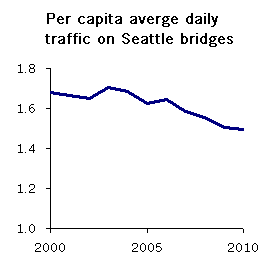 The Seattle Department of Transportation came out with its annual traffic report a week or so back. And the things that caught my eye (surprise, surprise) were the traffic trends.
The Seattle Department of Transportation came out with its annual traffic report a week or so back. And the things that caught my eye (surprise, surprise) were the traffic trends.
For years, Seattle has used traffic counts on bridges—the chart at the top—as the chief gauge of overall traffic trends in the city. According to the report: “We use these counts because driving almost anywhere in Seattle is likely to involve crossing one of the bridges.”
For 2010, traffic on Seattle bridges ticked upwards. But it was a modest increase, and it didn’t even keep up with population growth. Over the longer term, traffic on bridges has fallen pretty dramatically—and the declines started in 2003-2004, long before the economy tanked.
 Combining the two trends—less bridge traffic, more people—the city saw a major decline in per capita bridge traffic. All told, bridge crossings per capita are down 12 percent since 2003. A 12 percent decline may not sound like much, but it’s the same as shutting down all Seattle bridges for the month of November and half of December.
Combining the two trends—less bridge traffic, more people—the city saw a major decline in per capita bridge traffic. All told, bridge crossings per capita are down 12 percent since 2003. A 12 percent decline may not sound like much, but it’s the same as shutting down all Seattle bridges for the month of November and half of December.
Of course, this doesn’t necessarily mean that overall traffic volumes are changing at the same pace. People could be rearranging their travel to stay closer to home, and avoid crossing bridges. In fact, that’s what the traffic volume trends elsewhere in the document suggest: the city believes that average vehicle miles traveled on city arterials has remained much flatter than bridge traffic volumes.
But there’s other evidence that driving is down. Collision rates on city streets declined by an astonishing one-third from 2000 through 2010. Typically, that’s a sign of less driving per capita—and also a very healthy sign of a lower-risk transportation system.
I’m sure that some people find the idea of declining traffic disconcerting. For an awfully long time, many of us saw lots of driving as a sign of a healthy economy. But I actually find comfort in the trends. They show that, in an era of higher oil prices, we really can adjust our travel habits. And we make the adjustments so gradually that we barely notice them in our daily lives; it takes government statisticians (and geeks like me) to discover that we’re actually driving less.
